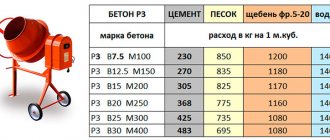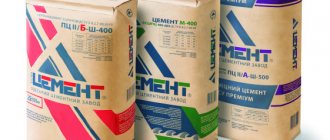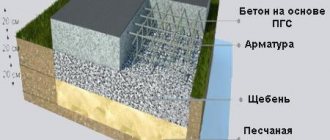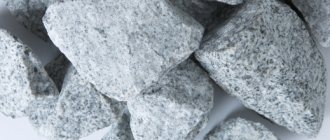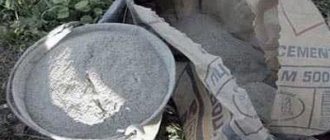Beton-House.com
Website about concrete: construction, characteristics, design. We combine the experience of professionals and private craftsmen in one place
Hardened concrete solution
Making “good” concrete for an experienced builder is a piece of cake when a beginner in this field is faced with a lot of information that needs to be taken into account when selecting a composition. The main mistake is to think that having high-quality components, any recipe will produce a high-quality mixture. But that's not true.
This factor affects success by only 40%. Approximately 10% can be given to the environmental conditions under which the concrete is prepared and cured.
And yes, 50% - the “lion’s share” - comes from competent selection of the composition. Why is it so important, and how to independently determine the correct ratio of sand, cement and crushed stone in concrete, let’s take a closer look.
Properties of components and their influence on composition selection
Concrete components
The number of components in concrete depends not only on its brand. The characteristics of the raw materials also have a huge impact, which can vary the ratio of cement, sand and crushed stone in concrete when producing a mixture of the same class.
Cement
Portland cement is the main binder. It is from its quantity that they start when determining the ratio.
And the calculation of cement for concrete depends on the following characteristics:
- Brand. The higher the grade of Portland cement, the greater its strength. Accordingly, the higher the grade, the less the amount of cement in a cube of concrete. The thought immediately arises: “I’ll buy the best cement, for example, M500D0, add its minimum amount, thereby saving on the most expensive component of concrete.” It’s hard to call such an act frugality, because the price for such a binder is decent.
Cement packed in 500 kg
Okay, let's go the other way, buy M400D20, which is cheaper, but this is also a dubious saving, since due to the lower grade strength, you need to add much more of it to the concrete, and the cost of the cube will increase accordingly. However, such a replacement is justified in many cases.
For example, when producing concrete of a grade not higher than M400, and only if the strength of the sample at 28 days of age meets the state standard requirements.
- Steaming activity is the most important characteristic of cement. It shows how quickly the concrete will gain formwork strength. It can be different even for cement from the same supplier for different batches. This parameter is determined only in laboratory conditions. There are 3 groups of steaming activity. The best is the first, and accordingly, the worst is the third.
Beams for determining activity during cement steaming
Which one is needed in a particular case depends on the specifics of production and the structure being manufactured. This does not particularly affect the ratio of cement and sand in concrete; they usually extend the heat and humidity regime or the standing time, if the activity is absolutely useless. But, if the budget allows and faster hardening of concrete is required, then in this case a larger volume is taken.
- The date of manufacture of cement is as important as the date of release of the food product. The fresher the binder, the better quality it is. Therefore, manufacturers do not purchase it in advance at a lower cost in the winter. After the “fulfillment” of the month of cement, a countdown begins. Its brand strength is slowly decreasing. This process occurs much faster if the cement is stored in open bags and in a moist environment. Therefore, “old” binder is added to concrete in excess of the norm.
Attention! If you come across lumpy cement, don’t feel sorry for it and throw it away, as nothing good can be made from it.
Water
Dosing water into solution
The water-cement ratio is a sore subject for any concrete worker.
As many people know, adding an excessive amount of water to the working solution leads to a decrease in grade strength.
- It must be dosed in the ratio of exactly the amount of cement used for 1 cubic meter of concrete, which is approximately 30% of its mass. That is why rigid semi-dry mixtures are distinguished by good brand strength, frost resistance and durability.
Semi-dry concrete with fiber
- But with this W/C solution, completely non-plastic solutions are obtained. Therefore, it is not always appropriate to make non-flowing mixtures.
- The concrete hardness grade is usually indicated in projects, but if it is not available, especially on construction sites, water is dosed “by eye,” which is not good.
- The table below clearly demonstrates the dependence of the strength of concrete on the amount of water in it.
Table of w/c ratio and strength
- Therefore, before putting the nominal mixture recipe into mass production, test batches are made during which the selection of the composition is adjusted.
- When testing samples in laboratory conditions, the most suitable concrete formulation for workability and strength is identified. This is why plasticizers are so loved by builders.
Plastic concrete: the ratio of cement and sand is normal
Note: Using plasticizers, you can reduce the w/c, and even the amount of cement, and still get “good” concrete. But, again, a dilemma arises - how profitable is this, because the price of plasticizers, oh, how “bites”! Therefore, “miracle masters” appear who advise adding cheap detergents to concrete, or “not bothering” at all and preparing solutions the old fashioned way.
What will win: “thrift” or “voice of reason”?
- I would also like to touch a little on the topic of water requirements for cement. This characteristic shows the water-cement ratio at which the normalized plasticity of Gost cement mortar is obtained.
- It does not have a huge impact on the proportions of cement sand and crushed stone for concrete. But it happens that some cements require a little more water, some a little less than the established value.
Cement beam test
- No additional tests are carried out to determine this property. This is clarified in the process of preparing cement paste for beams, which, after steaming, will be samples for testing the strength and activity of the binder.
Note! Knowing that the cement used in production has a high water requirement, the selection of the composition is not changed in advance, but they keep in mind that if the process of laying the mixture becomes more complicated, the water-cement ratio will need to be adjusted. In this case, samples of the batches must be taken for detailed laboratory testing.
Fillers
Now let’s plunge headlong into the abyss of information on large and small aggregates. When designing a certain brand of mixture, they try to minimize the consumption of cement for concrete, but at the same time, so that it corresponds to a certain brand strength and ductility.
To achieve this, large and fine aggregates are used. It not only reduces the amount of cement paste, but also adds strength characteristics (especially for crushed stone).
Cuboid crushed stone, fraction 20-40 mm
If we talk about heavy concrete, then when selecting the composition, the amount of sand is taken with some excess compared to the volume of crushed stone. In the case when a recipe for concrete made from sand and cement is calculated, then, provided that coarse aggregate is not used, the voids of the solution increases and is approximately 27%, which leads to a greater use of cement paste. And this is almost 2.5 times more than when dosing crushed stone.
Interesting fact! On construction sites, when monolithing large areas, for example, when pouring a slab foundation, “raisins” are used - cobblestones in order to spend as little expensive concrete as possible.
The photo shows different fractions of crushed stone
The size of the aggregates itself also plays an important role. Its fineness modulus is taken into account when designing concrete.
For example, for foundations, as a rule, crushed stone with a fraction of 20-40 mm is used, and for the production of floor slabs, aggregate with a particle size of 5-10 mm is used. At the same time, the ratio of crushed stone in concrete varies depending on the design grade. But, on average, approximately 5 parts of crushed stone are taken to 1 part of cement.
Preparation and proportions
For those wishing to prepare concrete themselves, we recommend using the tables. Although there are fairly simple formulas for calculating the composition, it is unlikely that anyone will use them - after all, not all people do construction every day. Therefore, a table of concrete proportions per 1 m³ will be very useful.
Tabular data
In the literature you can find various recommendations for calculating proportions. Some give them in mass fractions, others in volume fractions, but more often both are used. For example, here is a universal table:
| M concrete | M cement | crushed stone size, mm | cement, kg | cement, liters | sand, kg | sand, l | crushed stone, kg | crushed stone, l | water, l |
| 100 | 300 | 40 | 242,16 | 220,97 | 760 | 528 | 1132 | 839 | 208 |
| 100 | 300 | 20 | 257,3 | 234,09 | 760 | 704 | 1117 | 827 | 208 |
| 150 | 300 | 40 | 302,7 | 275,4 | 680 | 472 | 1211 | 816 | 211 |
| 150 | 300 | 20 | 322,88 | 293,62 | 671 | 465 | 1200 | 889 | 211 |
| 200 | 300 | 40 | 354,16 | 321,87 | 665 | 463 | 1173 | 869 | 205 |
| 200 | 300 | 20 | 378,38 | 344,07 | 640 | 444 | 1173 | 869 | 208 |
| 150 | 400 | 40 | 237,12 | 216,94 | 1165 | 532 | 1132 | 833 | 205 |
| 150 | 400 | 20 | 253,26 | 229,04 | 760 | 528 | 1123 | 831 | 208 |
| 200 | 400 | 40 | 282,52 | 257,3 | 751 | 521 | 1111 | 823 | 208 |
| 200 | 400 | 20 | 302,7 | 275,46 | 680 | 472 | 1211 | 896 | 211 |
| 300 | 400 | 40 | 414,7 | 376,36 | 655 | 455 | 1125 | 833 | 211 |
| 300 | 400 | 20 | 443,96 | 403,6 | 620 | 431 | 1131 | 837 | 211 |
| 150 | 500 | 40 | 201,8 | 176,58 | 811 | 563 | 1191 | 881 | 211 |
| 150 | 500 | 20 | 273,44 | 184,65 | 811 | 563 | 1180 | 881 | 200 |
| 200 | 500 | 40 | 247,21 | 214,92 | 755 | 524 | 1132 | 839 | 208 |
| 200 | 500 | 20 | 262,34 | 229,04 | 715 | 497 | 1175 | 871 | 211 |
| 300 | 500 | 40 | 383,42 | 333,98 | 660 | 459 | 1151 | 852 | 211 |
| 300 | 500 | 20 | 363,24 | 315,82 | 720 | 500 | 1111 | 889 | 211 |
| 400 | 500 | 40 | 438,92 | 382,41 | 625 | 435 | 1131 | 837 | 211 |
| 400 | 500 | 20 | 459,1 | 299,56 | 615 | 427 | 1115 | 827 | 211 |
Table 1 . Concrete, composition and proportions per 1 m³.
The table shows concrete with mobility grade P2, common in private housing construction. There are many options, as you can see above. Both the size of crushed stone and the grade of cement are taken into account. If the household has scales, then you can use them, but their absence is well compensated by buckets, the volume of which is 12 liters.
There are also more detailed tables from which you can calculate the proportions of the composition for a certain brand of mixture. For example, the composition of M300 concrete per 1 m³ in the table below is given depending on the degree of mobility:
| cone settlement (mobility), cm | cement M400 | crushed stone | sand | water |
| 1−2 | 335 | 1220 | 636 | 155 |
| 3−5 | 360 | 1202 | 630 | 165 |
| 6−8 | 380 | 1215 | 588 | 175 |
| 9−12 | 400 | 1200 | 560 | 185 |
Table 2 . The composition of M300 concrete has varying degrees of workability. All data is in kilograms.
You can often find proportions expressed in mass or volume fractions. The main thing here is to clarify whether we are talking about mass or volume, since only 1 liter of water weighs 1 kg. Here is an example of such a recommendation in shares:
| brand of cement | C, kg | P, kg | Shch, kg | C, l | P, l | Shch, l |
| M400 | 1 | 1.2 | 2.7 | 10 | 11 | 24 |
| M500 | 1 | 1.6 | 3.2 | 10 | 14 | 28 |
Table 3 . Concrete composition M400 per 1 m³.
The table, unfortunately, does not show how much water is required for kneading. But it gives a clear idea of how the brand of cement affects the required amount of aggregate. All data in the tables regarding aggregates is given for dry material. If the latter has moisture, then it must be taken into account when determining the amount of water.
Concrete recipe - everything has already been invented for us
Calculator for calculating the selection of concrete composition
Not a single legally binding regulatory document regulates the specific proportions of sand and cement for concrete. There are too many factors influencing this. But some provisions on the recipe can be found in GOST 27006-86 “Concrete. Rules for selecting the squad."
Again, it reflects everything in general terms. But I just want to know how much cement, sand, crushed stone is in 1 m3 of concrete of a particular brand. Such an opportunity exists today - composition selection calculators.
You simply enter the required class and brand of cement and get the desired recipe. But you should not treat it as a truly correct option. These figures are approximate.
The tables above show the approximate rates of cement, sand, and crushed stone for the most popular brands of concrete. Such values need to be adjusted after laboratory tests of test batch samples.Requirements for mixture components
For each substance included in concrete, GOST standards have been developed that contain requirements for the components. Before purchasing materials for construction, you need to familiarize yourself with these documents.
Choice of cement
The grade for mixing foundation concrete is determined according to SP 63.13330-2012. The values can be taken from the table.
| Designation according to GOST 31108-2003 | Designation according to GOST 10178-85 (obsolete) | Area of use |
| TsEM II/V-sh22.5 | ShPTs-300 | Footing for the foundation of a building |
| CEM III/A-sh22.5 | ||
| CEM II/A-sh32.5 | PC-400 D20 | Foundations for light individual houses |
| CEM I 32.5 | PC-400 D0 | Foundations for buildings with a large mass, when the requirements for moisture resistance and frost resistance are increased |
Sand selection
Sand is selected according to GOST 8736-93*. The main indicator of the material is the size of the fraction. The types of sand that can be used for the foundation are determined from the table:
| Aggregate size | Sand fraction, mm | Application area |
| Large | 2,5-3 | High grade concrete |
| Average | 2-2,5 | Main grades of concrete used in construction |
| Small | 1,5-2 | Can be used for concrete of small structures |
| Very small | 0-1,5 | Application is unacceptable |
| Thin | ||
| Very thin |
Expert advice
If we take into account the opinion of professionals, they advise doing foundation work exclusively in the summer months, thereby you will significantly reduce money and save time. To do similar work in winter, you will have to arm yourself not only with warm water, but also with professional additives.
The concrete itself, which will be poured into the formwork, will need to be heated. At sub-zero temperatures, water always freezes. If such a reaction occurs in the concrete solution, this will cause the water, in an altered state, to turn into ice and destroy the foundation.
Pouring the foundation
In addition, experts advise, for the sake of convenience, to keep the required portions of concrete in a bucket. For example, to prepare a solution you need to take a bucket of cement, crushed stone and 7 buckets of sand. If concrete is prepared following the correct ratio, it will have all the necessary characteristics.
Choice
The foundation is the load-bearing part of any building. To make it resistant to various loads, you need to choose the right composition of concrete for pouring it. In this case, its resistance to compression loads will be sufficient, which means it will be able to withstand the pressure of the entire house. Various grades of concrete are produced, so there are several composition options. Which one to choose for pouring the foundation? This question must be answered taking into account two factors:
- Features of the structure (number of floors, weight, size of the basement).
- Features of the soil on the site.
The choice of composition taking into account the first factor is made as follows:
- M 150 is used for pouring foundations for frame and panel buildings.
- For light houses made of logs and timber, M 200 is selected.
- M 300 for block and brick buildings.
The dependence on the characteristics of the site is as follows. The more complex the soil on the site, the higher the grade of concrete you need to choose. So, for rocky soil it is enough to prepare a solution of M 150. For loamy soil, the composition M 200 is suitable.
How to choose the right materials?
Before combining all the ingredients for concrete in certain proportions, you need to select the necessary materials . Surely many people know that concrete structures (this also applies to the base) are made of different materials. These are cement, sand, and crushed stone.
All components must meet the prescribed quality criteria. The sand must be cleaned; it must not contain clay or silt impurities, even if their amount is minimal.
It is better when foundation building mixtures contain sand granules several millimeters in size. For example, the finest sand is used to prepare concrete type M200, and large grains of sand are included in the composition M350.
Sand is most often obtained naturally. It can be sea, quarry or river, and is often mined by crushing gravel using a special machine.
In the latter case, the material often contains gravel extracts.
Sea sand
The size of the building should guide the choice of crushed stone for the foundation. For more massive structures, builders often opt for the granite variety of crushed stone, and for small houses - limestone. It is significantly lighter and more affordable.
The middle option is considered to be crushed gravel; it is more affordable when compared with granite, but stronger when compared with limestone.
For the foundation, a cube-shaped fraction from 4 cm is often used, thanks to which it is possible to achieve excellent compaction.
The use of flat and angular elements is undesirable because they adversely affect the durability of the structure and the resistance of concrete structures to frost.
crushed gravel
There is more than one brand of cement on the market, but if builders are planning to carry out foundation work, then not every one will be suitable. In practice, grades 500 and 400 are often used; they have excellent resistance to cold and moisture, and this is very important if construction is carried out in Russia.
If the grade is below 400, the concrete is severely deformed during the shrinkage stage, so builders do not recommend using it.
It is also recommended to use exclusively “fresh” cement during the construction stage, all because this material is capable of changing its characteristics: after six months, up to half of its characteristics are lost.
Conditions to achieve maximum strength
- In order for the base of the result to be as strong and durable as possible, it is necessary not only to take into account the percentage of different components, but also to comply with certain technological conditions;
- In order to obtain certain characteristics, it is necessary to pay attention to the ratio of components and maintain them with milligram precision. This is best achieved in a factory where all components are loaded without human intervention;
- at home, when there is no information on the sizes of sand particles of sand and crushed stone fractions, it is rational to resort to a proven method to determine the ratio of substances relative to each other;
- For this purpose, a classic bucket is used, into which crushed stone is compacted through rapid shaking. Gradually, H2O is added until all components are covered. Its volume is directly proportional to the volume of sand;
- Then the crushed stone should be shaken out of the bucket, the required amount of sand is placed there, which is also filled with water until it is completely filled. As a result, the volume of water will be able to indicate the required amount of cement. After which all proportions are calculated;
- When pouring the base, the consistency of the mixture plays an important role. There should be no lumps or air bubbles in it. Therefore, it is more rational to purchase either store-bought concrete, or devote a few minutes to personal mixing with future processing in a special machine;
- You only need to fill the mixture once. In other words, it is irrational to consider the option when part of the base has already been erected, and for another part the solution is just beginning to be mixed. As a result of such an error, “dead seams” appear, which will soon turn into cracks.
When calculating the required proportions, do not forget about the fractions of the filler, and also take into account the requirements that apply to the future foundation . This article provided data that can be used to build a house.


